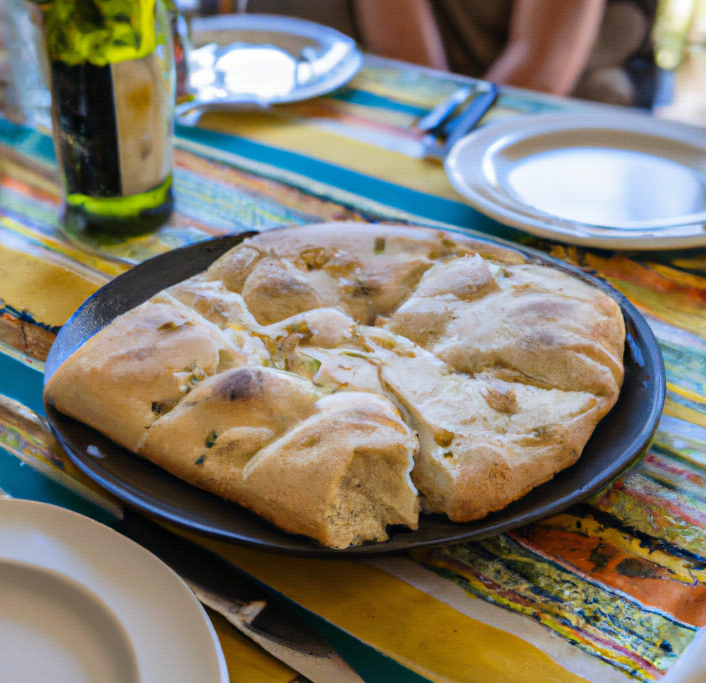What is Focaccia: A Comprehensive Guide

Focaccia is a beloved Italian flatbread characterized by its thick, fluffy texture, dimpled surface, and rich olive oil flavor. Its versatility and popularity have made it a staple in Italian cuisine and a favorite among bread enthusiasts worldwide.
History of Focaccia
Focaccia’s origins can be traced back to ancient Italy, where it was known as “panis focacius” or “hearth bread.” It was traditionally cooked on hot ashes or stone slabs. Over time, focaccia became a staple food in the Liguria region of Italy, particularly in the city of Genoa.
Focaccia Ingredients
The essential ingredients for making focaccia include:
- Flour: High-gluten flour, such as bread flour, is used to give the bread its structure and chewiness.
- Water: Water hydrates the flour and activates the yeast.
- Yeast: Instant or active dry yeast is used to leaven the dough.
- Salt: Salt enhances the flavor and balances the sweetness of the olive oil.
- Olive oil: Olive oil is generously used to coat the dough, giving it a rich flavor and golden crust.
Focaccia Preparation
Making focaccia involves the following steps:
- Mixing the dough: The dry ingredients are mixed together before adding the water and olive oil. The dough is then kneaded until it becomes smooth and elastic.
- First rise: The dough is left to rise in a warm place until it doubles in size.
- Shaping: The risen dough is stretched or rolled out into a rectangular or round shape.
- Dimpled surface: Fingertips are pressed into the dough to create dimples that will allow the olive oil to pool during baking.
- Second rise: The shaped dough is left to rise again until it almost doubles in size.
- Toppings: Various toppings, such as herbs, olives, or cheese, can be added before baking.
- Baking: Focaccia is baked in a hot oven until it is golden brown and cooked through.
Types of Focaccia
There are several regional variations of focaccia, each with its unique characteristics:
- Focaccia Genovese: Originating from Genoa, this classic focaccia is characterized by its thick, fluffy texture and dimpled surface. It is often topped with coarse salt.
- Focaccia Ligurian: This focaccia is thinner and crispier than Genovese. It is commonly topped with herbs, such as rosemary or sage.
- Focaccia Roman: Roman focaccia is a thick and rectangular bread with a crispy crust. It is often topped with olives, onions, or tomatoes.
Focaccia Toppings and Variations
Focaccia offers endless possibilities for toppings and variations. Some popular options include:
- Herbs: Rosemary, thyme, and oregano are classic herb toppings that add a fragrant aroma and flavor.
- Olives: Olives, both black and green, provide a salty and tangy contrast to the focaccia.
- Onions: Sliced onions add a sweet and savory flavor to the bread.
- Tomatoes: Diced tomatoes add a juicy and flavorful element.
- Cheese: Grated Parmesan or crumbled feta cheese can add a rich and creamy texture.
- Garlic: Minced garlic adds a pungent and aromatic flavor.
Conclusion
Focaccia is a versatile and delicious bread that has stood the test of time. Its simple ingredients and easy preparation make it accessible to home bakers of all skill levels. Whether enjoyed plain or adorned with various toppings, focaccia is a culinary delight that satisfies both the palate and the soul.
Sources
FAQs
What is focaccia?
Focaccia is a thick, fluffy Italian flatbread with a dimpled surface and a rich olive oil flavor. It is typically made with high-gluten flour, water, yeast, salt, and olive oil.
Where did focaccia originate?
Focaccia originated in ancient Italy, where it was known as “panis focacius” or “hearth bread.” It was traditionally cooked on hot ashes or stone slabs. Over time, focaccia became a staple food in the Liguria region of Italy, particularly in the city of Genoa.
What are the key ingredients in focaccia?
The essential ingredients for making focaccia include:
- High-gluten flour
- Water
- Yeast
- Salt
- Olive oil
How is focaccia made?
Making focaccia involves the following steps:
- Mixing the dough
- First rise
- Shaping
- Dimpled surface
- Second rise
- Toppings (optional)
- Baking
What are the different types of focaccia?
There are several regional variations of focaccia, each with its unique characteristics:
- Focaccia Genovese: Originating from Genoa, this classic focaccia is characterized by its thick, fluffy texture and dimpled surface. It is often topped with coarse salt.
- Focaccia Ligurian: This focaccia is thinner and crispier than Genovese. It is commonly topped with herbs, such as rosemary or sage.
- Focaccia Roman: Roman focaccia is a thick and rectangular bread with a crispy crust. It is often topped with olives, onions, or tomatoes.
What are some popular toppings for focaccia?
Focaccia offers endless possibilities for toppings and variations. Some popular options include:
- Herbs (rosemary, thyme, oregano)
- Olives (black or green)
- Onions
- Tomatoes
- Cheese (Parmesan, feta)
- Garlic
